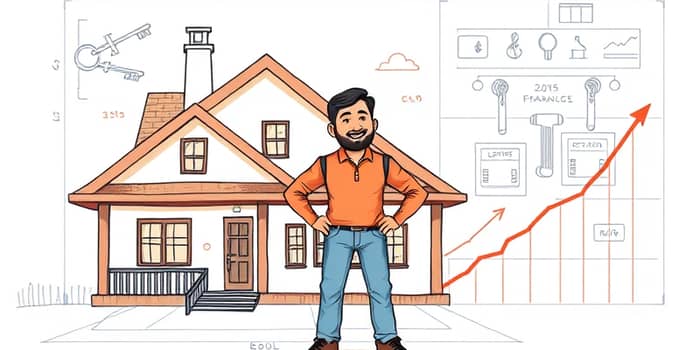Every homeowner faces moments of uncertainty when market conditions shift or financial goals evolve. The prospect of lower payments, faster equity growth, or accessing cash for life’s milestones can feel daunting if you’re unsure where to begin.
By understanding how to approach refinancing, you can transform your mortgage into a strategic asset that aligns with your aspirations. Whether you’re aiming to lock in lower interest rates or tap into funds for college tuition, the journey begins with informed decisions.
Understanding Loan Refinancing
Refinancing, often called a “refi,” means replacing an existing loan with a new one under revised terms. While most commonly applied to mortgages, this concept can extend to student loans, auto loans, and other debt types.
At its core, a refinance involves paying off your current loan with proceeds from a new loan. This enables borrowers to convert to a fixed rate from an adjustable one or adjust the loan term to better suit evolving needs.
Key Reasons to Refinance
Homeowners pursue refinancing for a variety of strategic motives. Identifying your primary goal will guide every subsequent step.
- Secure a significantly lower interest rate and reduce monthly payments.
- Shorten or extend the loan term to match life stage or cash flow.
- Access meaningful home equity through a cash-out refinance.
- Consolidate high-interest debts into a single, manageable payment.
- Eliminate private mortgage insurance when equity thresholds are met.
Recognizing which benefit matters most will help you craft a tailored refinancing strategy that works in your favor.
Pros and Cons of Refinancing
Refinancing can unlock significant advantages, but it also carries costs and risks. A clear comparison helps you balance potential rewards against possible downsides.
While refinancing can deliver substantial interest savings over time, you must weigh upfront costs and the possibility of extending your repayment horizon.
Step-by-Step Refinancing Process
With a clear goal in mind, follow these structured steps to navigate the refinancing journey:
- Determine refinancing goals: Decide whether you aim to reduce payments, shorten term, or extract cash for other needs.
- Research loan options: Compare rate-and-term vs. cash-out refinancing offers from multiple lenders.
- Calculate potential savings: Factor in closing costs and break-even point to ensure tangible benefits.
- Gather documentation: Assemble income statements, tax returns, credit reports, and property details.
- Submit applications: Apply with chosen lenders, providing all required documentation promptly.
- Underwriting and appraisal: Lenders verify your financial profile and order a property appraisal.
- Review closing disclosure: Examine final costs, terms, and ensure they align with your expectations.
- Close the loan: Sign the paperwork and see your original loan paid off by the new lender.
Patience and meticulous preparation during this phase will significantly reduce surprises at closing.
Timing and Risk Mitigation
Refinancing at the right moment can amplify your savings, but mistimed decisions may erode potential benefits. Keep these strategies in mind:
- Monitor interest rate trends and act when they dip below your current rate by at least 1%.
- Maintain or improve your credit score before applying to secure the best terms.
- Aim for a healthy loan-to-value ratio—more equity often translates to better offers.
- Calculate your break-even point to ensure closing costs pay off within a reasonable timeframe.
Implementing these safeguards helps you avoid common pitfalls and positions you to recover closing costs quickly without overextending.
When It Makes Sense to Refinance
Not every rate dip or financial shift warrants refinancing. Consider pulling the trigger when all these conditions align:
• Your current rate is significantly higher than prevailing market rates.
• Your credit profile has strengthened since taking out the original loan.
• You’ve built substantial equity in your property.
• You’re prepared to stay in the home long enough to break even on costs.
When these factors converge, refinancing transforms from a mere option into a powerful shortcut toward financial freedom.
Special Considerations
Several nuanced factors can influence your decision and ultimate satisfaction with a refinance:
• Low appraisals may require renegotiation or additional down payment to achieve target loan amounts.
• Cash-out refinances increase your debt load—only borrow what you truly need.
• Tax implications can shift; consult a professional to understand mortgage interest deductions under new terms.
• Stay vigilant about prepayment penalties or adjustable-rate reset dates buried in fine print.
By paying attention to these details, you safeguard against unexpected costs and ensure a smoother transition to your new loan.
Conclusion
Loan refinancing is more than a financial maneuver—it’s a strategic decision that can reshape your long-term stability. Armed with knowledge of the process, clear objectives, and careful timing, you can convert market fluctuations into an opportunity for growth.
Whether you seek to simplify multiple debt payments, reduce monthly obligations, or harness your home’s equity for life’s next chapter, the path to a successful refinance starts with informed choices and disciplined execution.
Embrace the process with confidence, and let your new loan reflect not just your past obligations, but your future ambitions.
References
- https://www.investopedia.com/terms/r/refinance.asp
- https://www.rocketmortgage.com/learn/pros-and-cons-of-refinancing
- https://www.experian.com/blogs/ask-experian/pros-and-cons-refinancing-you-home/
- https://gucu.org/learn/learning-center/resource-detail/education/2020/10/20/loan-refinancing-basics
- https://www.quickenloans.com/learn/what-is-refinancing
- https://www.rocketmortgage.com/learn/how-does-refinancing-work
- https://better.com/content/5-tips-to-prepare-for-a-refinance
- https://www.investopedia.com/terms/r/refinancing_risk.asp










